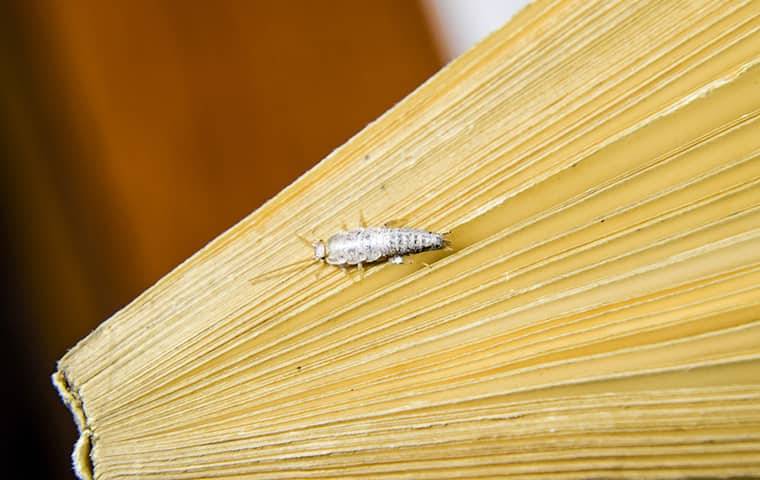
Silverfish In Charlotte Can Be Tricky To Get Rid Of
Silverfish are a sneaky little pest. They're tiny, but they can take over your home if you don't keep tabs on them. Silverfish in Charlotte are one of the most common household pests. You know when you have them because of their silver color and long antennae. However, they can be tricky to get rid of because they like to hide in cracks and crevices around your home where it's hard to notice them. Read on for everything you need to know about silverfish and how Charlotte pest control can help you get rid of them.

What Is A Silverfish?
If you've ever seen a silverfish, you're probably familiar with its silver-colored appearance and long antennae. Silverfish are small, wingless, and flat. Their body is tapered, wider at the head, and thinner at the back, much like a carrot. They can measure anywhere between 1/2 to 3/4 inches in length.
Silverfish have two long antennae that extend from their head region and three long bristly appendages that extend from the thorax region of their body. That is why they are also sometimes called bristletails. These insects possess compound eyes located on top of their heads between the second pair of legs which are used for sensing light intensity levels during the night hours when they typically come out looking for food sources.
Silverfish are usually gray or brown in color. The scales on their back detach easily when predators like centipedes or spiders try to grab them. This allows the silverfish to escape from predators and continue their lives. They are also good swimmers and can even live in water for a short period of time.
The ideal silverfish habitat is a damp area with high humidity. They like to live in basements and are often found under sinks or in bathrooms. They can also inhabit humid attics and crawl spaces. Silverfish like to breed in moist areas with a lot of food available. The silverfish lays from one to three eggs per day, placing them in cracks or under objects. Developmental time is approximately three to four months when conditions are favorable. Most silverfish live up to about three years.
Silverfish feed on a wide variety of materials, including paper and glue. They also eat clothing made from natural fibers such as wool or silk and food items containing starch like rolled oats. They prefer the taste of proteins to carbohydrates and eat their own species if injured or dead. This cannibalism often happens when a silverfish is molting because they are particularly vulnerable at that time.
The Problems Silverfish Can Create In Your Home
Silverfish do not bite or spread disease, so they are not considered harmful to humans. However, the insects can cause harm to personal belongings—especially those made of paper. Silverfish are able to digest the glue used in books and paper products, making them a nuisance to libraries and book collectors. The insects also eat other paper products including cardboard boxes, cereal boxes, wallpaper, and tissue paper. Without better options, they may also damage leather goods such as shoes, purses, or belts.
Silverfish also tend to eat starchy or protein-rich human food, so your kitchen is not immune to them. They eat a wide variety of foods, including breadcrumbs, flour, and sugary item. Even small amounts of these materials can sustain their population. Adult silverfish can survive for several months without eating. Since many people's pantries are stocked with cardboard boxes of food and paper products, these areas are particularly susceptible to silverfish infestation.
Silverfish cause problems in the bathroom as well. They are attracted to soap, lotion, and toothpaste and will eat the paste from the tube. They also will eat soap from the sink or tub. The dead skin cells and dandruff from your hairbrush can be a source of food for silverfish.
If you are finding silverfish damage to your personal belongings, it is possible that you have a silverfish infestation. The experts at Go-Forth Home Services can help you determine if you have a silverfish problem and how to get rid of them.
How Silverfish Find Their Way Into Your Home
Silverfish often find their way into buildings in books, boxes, and papers from an infested location. They also commonly infest wet cardboard boxes. Moisture and dampness are very attractive to silverfish, and they will find their way into your home through cracks in walls and windowsills. Silverfish can also enter your home through window screens that are damaged or torn. They can fit through very small cracks and openings. Silverfish often prefer dark, damp areas like basements and cellars. They will also enter through cracks in the foundation of your home. If you see silverfish in your home or have an infestation, consider how they might be getting inside.
How Can I Stop Silverfish From Getting Into My Home?
Preventing silverfish infestations involves several tactics. A combination of prevention and control is the best way to get rid of silverfish. Suggestions for controlling or preventing silverfish include:
- Store flour, cookies, and other dry goods in tightly sealed containers so they cannot access these foods.
- Dehumidify your home. Because silverfish prefer damp areas, you can discourage them by keeping your home well-ventilated.
- Repair all leaks in your home. A leak in your home can make the situation worse. The more moisture there is, the better your chance of having silverfish problems. Check all pipes and drains to make sure they are sealed tightly. Also, inspect the exterior of your home for any openings that may be allowing water into the structure and seal them up. This is especially important if you live in an area where there is a lot of rain or flooding.
- Remove all wet and water-damaged wood and other building materials from your home that could be a breeding ground for silverfish. If you have any damp or damaged wood in your home, it should be removed and disposed of immediately.
- Inspect your home for openings where silverfish can enter and seal them up. Silverfish may enter your home through cracks or holes in the foundation, pipes that lead outside, or through any other openings.
- Do not leave paper products, such as books and magazines, on the floor—store all books in bookcases or cabinets, or better yet, sealed containers.
- Swap out cardboard storage boxes for plastic totes with sealing lids.
- Vacuum and clean often. By regularly cleaning the house, you will eliminate food sources and destroy silverfish eggs.
- Make a silverfish trap. You can trap silverfish in a glass or jar by filling it with a mixture of water and soap. The silverfish will get stuck on the surface of the water and die. These silverfish bait traps work best if you place them near where you have seen silverfish before. If your home has an infestation, place several traps throughout your house.
- Use diatomaceous earth. Diatomaceous earth is a powder made from fossilized organisms, and it can kill insects by getting into their exoskeletons. Sprinkle diatomaceous earth in areas of your home where you've seen silverfish—behind appliances or under the sink are good spots! It's safe for pets and people, so you can leave it in out-of-the-way places or vacuum it up later.
- Use cedar shavings or oil. Place shavings in places where you know silverfish to be active, such as garages and storage facilities, along with any containers that contain papers or clothing. Applying a silverfish repellent like cedar oil to baseboards, cracks, and other spaces where silverfish are likely to hide will help deter the insects.
- Protect your clothing with mothballs or other repellants. Mothballs, bay leaves, and lavender can all be used to keep silverfish away. Place mothballs in the back of closets, on shelves, and anywhere else that you know silverfish are likely to be active. The same goes for bay leaves and lavender.
Proper silverfish control is tricky and sometimes requires a professional. Silverfish are a pest that can be very difficult to exterminate because they hide in cracks and crevices, making detection and control difficult. They also have the ability to live for a long time without food. This means that even if you do manage to get rid of them in one location, they will likely return if left untreated elsewhere in your home.
If you suspect that silverfish are living in your Charlotte home, contact Go-Forth Home Services today. Silverfish are a common problem in the Charlotte area, but we can help you get rid of them. Our pest control services are effective and affordable. Go-Forth Home Services is your one-stop shop for all of your Charlotte pest control needs. We have the experience and expertise to get rid of silverfish in your home, as well as other pests like termites and roaches.
Contact us today for more information about our services or to schedule an appointment with one of our professional technicians.
Customer Reviews
-
“He spent time educating us about "pests" and provided information regarding services with GoForth.”- Joyce C.
-
“Texted me before coming. Worked with me playing musical rooms with my dogs. I'll see how things are.”- Constance E.
-
“Amazing response time, reasonable prices, great customer service. Tevin was thorough and confident in his plan to fix our horrendous fire ant problem. We have had negative experiences with prior exterminators and probably waited way too long to call Go-For”- Ashley T.
-
“- Toya B.
We have been customers for almost 7 years for a reason. Our technician is the best. He always knows exactly how to address whatever pest has decided to bother us. We have referred them to many of our neighbors. Well worth the cost not to have to worry a
” -
“Answered all my questions and I felt their pricing was very reasonable.”- Deborah J.
-
“Brian went above and beyond what was expected, and I hope I get him again as my technician for future services!”- Tam L.
-
“He was thorough with inspecting and treating our home, which I really appreciate, and he took the time to answer my many questions.”- Jasmine B.
-
“Love the detailed summary and pics of what he did and saw! And did I mention how wonderful Olivia was to get us all set up?!!”- Beechy A.


Over the years, we’ve boiled down our mission to a core set of values:
-
Give A CrapDelight others by owning your role and saying yes. Take pride in how you appear & act & every other detail of the job. Be on time, attentive, & enthusiastic. Act as if the buck stops with you on every aspect of the job.
-
Chase PerfectionChase Perfection, knowing full well we will not reach it, but along the way we will catch excellence. Have a sense of urgency; Go-Forth Time - right now might be the only time you have to get it right.
-
Dig Deeper
Be an action-oriented professional that makes decisions based on evidence rather than stories & assumptions. Stay curious. Data can speak for itself.
Understand the cause of the fire rather than rushing to extinguish it.
-
Fight For SimplicityKeep it simple & consistent. Focus on how things should be done every time.
-
Face It, Fix ItConfront challenges directly and address issues head-on. A bias for action and powerful conversations drive our progress. It’s about getting it right rather than being right.
-
Grow!Growth is our purpose. Growing as people & growing our business.